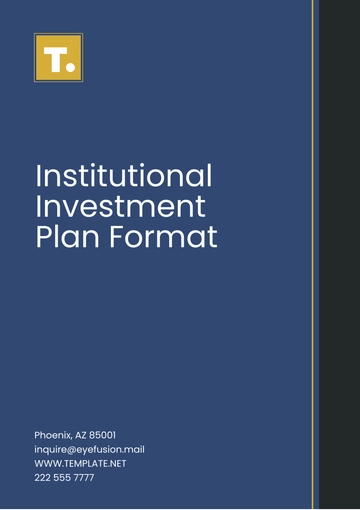Free Investment Plan

I. Introduction
Investing is a cornerstone of financial planning and wealth management, essential for building and preserving wealth over time. This plan presents a structured, strategic approach to investing that seeks to maximize returns while managing risk. Whether you are new to investing or looking to refine your existing strategy, this guide provides actionable insights to help you achieve your financial goals.
II. Investment Objectives
A. Short-term Objectives
Focus on capital preservation and achieving returns within a short timeframe, typically a few months to a few years.
Investments may include high-quality bonds, money market funds, or other low-risk instruments.
B. Medium-term Objectives
Encompass goals within a 3 to 5-year timeframe, balancing growth and stability through moderate-risk assets.
Diversification is key, with a mix of bonds, balanced funds, and select equities to aim for a balance between risk and return.
C. Long-term Objectives
Extend beyond five years, aiming for significant growth and wealth accumulation.
Higher-risk assets such as equities and real estate are emphasized for their potential for larger returns over time.
III. Risk Assessment and Management
A. Risk Tolerance
A personal evaluation of how much risk is manageable is influenced by factors such as age, financial situation, and long-term goals.
A risk tolerance questionnaire or consultation with a financial advisor can help pinpoint a suitable risk level.
B. Risk Management
Strategies like diversification, asset allocation, and regular portfolio review are critical to aligning the investment approach with risk tolerance.
Techniques such as stop-loss orders, dollar-cost averaging, and hedging strategies provide added layers of risk control.
C. Emergency Fund
An emergency fund ensures liquidity and acts as a financial buffer against market downturns or unexpected expenses, covering at least 3-6 months of expenses.
This fund should be maintained in low-risk, highly liquid investments like money market funds or high-yield savings accounts.
IV. Asset Allocation and Diversification
A. Asset Allocation
Asset allocation divides investments among various asset classes to balance risk and return based on individual financial goals, risk tolerance, and investment horizon.
Asset Class | Percentage Allocation |
|---|---|
Equities | 40% |
Bonds | 30% |
Real Estate | 20% |
Cash | 10% |
B. Diversification
Diversification within and across asset classes helps reduce risk by spreading investments across sectors, geographic regions, and asset types.
Strategies may include sector-based diversification in equities, a mix of corporate and government bonds, and international exposure.
V. Investment Options
A. Stocks
Provides high growth potential but comes with greater volatility.
Research and analysis are essential for selecting stocks with strong fundamentals, growth potential, and industry relevance.
B. Bonds
Generally safer investments offering fixed returns, suitable for income generation and capital preservation.
Choices include government bonds, corporate bonds, municipal bonds, and high-yield bonds, each with varying risk levels.
C. Mutual Funds
Offer professional management and diversified exposure across asset classes, ideal for both beginner and seasoned investors.
Choices include equity funds, bond funds, balanced funds, and index funds depending on risk tolerance and investment goals.
D. Real Estate
Involves direct or indirect investment in property, providing rental income and potential appreciation.
Options may include residential properties, commercial real estate, REITs, and real estate crowdfunding.
E. Index Funds and ETFs
Track specific market indices, offering broad exposure at lower costs.
Both are typically diversified, tax-efficient, and suited to passive investment strategies.
F. Alternative Investments
Investments such as commodities, hedge funds, and private equity can add diversification and return potential but may have higher risks and lower liquidity.
Suitable for experienced investors with a higher risk tolerance.
VI. Tax Efficiency
A. Tax-Advantaged Accounts
Consider using accounts such as IRAs, 401(k)s, or tax-free savings accounts to defer or reduce taxes on investment gains.
Tax-advantaged accounts are ideal for long-term growth and retirement planning.
B. Tax-Efficient Investing
Using strategies such as holding investments long-term, tax-loss harvesting, and selecting tax-efficient funds (like index funds) can reduce tax liability.
Annual reviews with a tax advisor can help to optimize tax efficiency.
VII. Monitoring, Rebalancing, and Performance Evaluation
A. Regular Monitoring
Regularly review your portfolio’s performance to ensure alignment with objectives.
Adjust for major life changes, market conditions, or shifts in personal goals.
B. Rebalancing
Rebalancing maintains the target asset allocation, typically conducted annually or semi-annually.
Rebalancing can be based on a predetermined time frame or triggered by changes in asset values.
C. Performance Evaluation
Evaluate your portfolio's performance by comparing it to benchmarks (e.g., S&P 500, bond indices) to gauge returns.
Performance evaluation helps identify any need for adjustments and measure progress toward goals.
VIII. Financial Advisory and Resources
A. Financial Advisors
A financial advisor can provide personalized guidance, especially for complex portfolios or alternative investments.
Advisors can offer insight into market trends, asset allocation, and tax strategies tailored to individual needs.
B. Educational Resources
Regularly educate yourself on investment trends and strategies through books, seminars, reputable online resources, and financial news.
Continuous learning can enhance decision-making and adaptability to evolving market conditions.
IX. Conclusion
Investing is a journey that requires thoughtful planning, disciplined risk assessment, and regular review. A structured investment plan that incorporates clear objectives, diversified asset allocation, and tax-efficient strategies can provide a roadmap for achieving financial security and long-term wealth. With a commitment to monitoring and adapting this plan over time, you can work toward meeting your financial goals efficiently and effectively.
- 100% Customizable, free editor
- Access 1 Million+ Templates, photo’s & graphics
- Download or share as a template
- Click and replace photos, graphics, text, backgrounds
- Resize, crop, AI write & more
- Access advanced editor
You may also like
- Finance Plan
- Construction Plan
- Sales Plan
- Development Plan
- Career Plan
- Budget Plan
- HR Plan
- Education Plan
- Transition Plan
- Work Plan
- Training Plan
- Communication Plan
- Operation Plan
- Health And Safety Plan
- Strategy Plan
- Professional Development Plan
- Advertising Plan
- Risk Management Plan
- Restaurant Plan
- School Plan
- Nursing Home Patient Care Plan
- Nursing Care Plan
- Plan Event
- Startup Plan
- Social Media Plan
- Staffing Plan
- Annual Plan
- Content Plan
- Payment Plan
- Implementation Plan
- Hotel Plan
- Workout Plan
- Accounting Plan
- Campaign Plan
- Essay Plan
- 30 60 90 Day Plan
- Research Plan
- Recruitment Plan
- 90 Day Plan
- Quarterly Plan
- Emergency Plan
- 5 Year Plan
- Gym Plan
- Personal Plan
- IT and Software Plan
- Treatment Plan
- Real Estate Plan
- Law Firm Plan
- Healthcare Plan
- Improvement Plan
- Media Plan
- 5 Year Business Plan
- Learning Plan
- Marketing Campaign Plan
- Travel Agency Plan
- Cleaning Services Plan
- Interior Design Plan
- Performance Plan
- PR Plan
- Birth Plan
- Life Plan
- SEO Plan
- Disaster Recovery Plan
- Continuity Plan
- Launch Plan
- Legal Plan
- Behavior Plan
- Performance Improvement Plan
- Salon Plan
- Security Plan
- Security Management Plan
- Employee Development Plan
- Quality Plan
- Service Improvement Plan
- Growth Plan
- Incident Response Plan
- Basketball Plan
- Emergency Action Plan
- Product Launch Plan
- Spa Plan
- Employee Training Plan
- Data Analysis Plan
- Employee Action Plan
- Territory Plan
- Audit Plan
- Classroom Plan
- Activity Plan
- Parenting Plan
- Care Plan
- Project Execution Plan
- Exercise Plan
- Internship Plan
- Software Development Plan
- Continuous Improvement Plan
- Leave Plan
- 90 Day Sales Plan
- Advertising Agency Plan
- Employee Transition Plan
- Smart Action Plan
- Workplace Safety Plan
- Behavior Change Plan
- Contingency Plan
- Continuity of Operations Plan
- Health Plan
- Quality Control Plan
- Self Plan
- Sports Development Plan
- Change Management Plan
- Ecommerce Plan
- Personal Financial Plan
- Process Improvement Plan
- 30-60-90 Day Sales Plan
- Crisis Management Plan
- Engagement Plan
- Execution Plan
- Pandemic Plan
- Quality Assurance Plan
- Service Continuity Plan
- Agile Project Plan
- Fundraising Plan
- Job Transition Plan
- Asset Maintenance Plan
- Maintenance Plan
- Software Test Plan
- Staff Training and Development Plan
- 3 Year Plan
- Brand Activation Plan
- Release Plan
- Resource Plan
- Risk Mitigation Plan
- Teacher Plan
- 30 60 90 Day Plan for New Manager
- Food Safety Plan
- Food Truck Plan
- Hiring Plan
- Quality Management Plan
- Wellness Plan
- Behavior Intervention Plan
- Bonus Plan
- Investment Plan
- Maternity Leave Plan
- Pandemic Response Plan
- Succession Planning
- Coaching Plan
- Configuration Management Plan
- Remote Work Plan
- Self Care Plan
- Teaching Plan
- 100-Day Plan
- HACCP Plan
- Student Plan
- Sustainability Plan
- 30 60 90 Day Plan for Interview
- Access Plan
- Site Specific Safety Plan





























